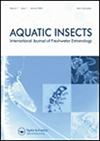中国中部亚热带三峡水库支流水豚和杜金的生活史,2002(蜉蝣目:水豚科)
IF 0.6
4区 农林科学
Q4 ENTOMOLOGY
引用次数: 0
摘要
摘要本文首次研究了胡蜂(Caenis lubrica Tong)和杜金蜂(Dudgeon)的生活史。我们在中国中部亚热带的三峡水库湘西湾的庞斜溪进行了调查。2017年1月至12月,每月采集幼虫样本。Caenis lubrica在这个系统中表现出三价性,有一个越冬代和两个夏季代。越冬代的群体生产间隔(CPI)为6个月,从11月到4月,夏季两代的CPI分别为1个月,分别从6月到7月和7月到8月。据估计,C.lubrica越冬代和夏季两代幼虫发育的累积天数为1829.24天 °C,904.84 °C和859.83 °C。本文章由计算机程序翻译,如有差异,请以英文原文为准。
Life history of Caenis lubrica Tong and Dudgeon, 2002 (Ephemeroptera: Caenidae) in a Three Gorges Reservoir feeder stream, subtropical Central China
Abstract Life history of Caenis lubrica Tong and Dudgeon, 2002 (Ephemeroptera: Caenidae) was studied for the first time. We investigated it in Pangxie Stream, which feeds into the Xiangxi River Bay, Three Gorges Reservoir in subtropical Central China. Monthly samples of larvae were taken from January to December, 2017. Caenis lubrica was determined to exhibit trivoltinism in this system, having an overwintering generation and two summer generations. The cohort production interval (CPI) of the overwintering generation was six months, from November to April, and the CPIs of the two summer generations were one month each, from June to July and from July to August. The Accumulated Degree Days of C. lubrica for larval development of the overwintering generation and the two summer generations were estimated to be 1829.24 °C, 904.84 °C, and 859.83 °C, respectively.
求助全文
通过发布文献求助,成功后即可免费获取论文全文。
去求助
来源期刊

Aquatic Insects
生物-昆虫学
CiteScore
2.00
自引率
25.00%
发文量
27
审稿时长
>12 weeks
期刊介绍:
Aquatic Insects is an international journal publishing original research on the systematics, biology, and ecology of aquatic and semi-aquatic insects.
The subject of the research is aquatic and semi-aquatic insects, comprising taxa of four primary orders, the Ephemeroptera, Odonata, Plecoptera, and Trichoptera but also aquatic and semi-aquatic families of Hemiptera, Coleoptera, and Diptera, as well as specific representatives of Hymenoptera , Lepidoptera, Mecoptera, Megaloptera , and Neuroptera that occur in lotic and lentic habitats during part of their life cycle. Studies on other aquatic Hexapoda (i.e., Collembola) will be only accepted if space permits. Papers on other aquatic Arthropoda (e.g., Crustacea) will not be considered, except for those closely related to aquatic and semi-aquatic insects (e.g., water mites as insect parasites).
The topic of the research may include a wide range of biological fields. Taxonomic revisions and descriptions of individual species will be accepted especially if additional information is included on habitat preferences, species co-existing, behavior, phenology, collecting methods, etc., that are of general interest to an international readership. Descriptions based on single specimens are discouraged.
Detailed studies on morphology, physiology, behavior, and phenology of aquatic insects in all stadia of their life cycle are welcome as well as the papers with molecular and phylogenetic analyses, especially if they discuss evolutionary processes of the biological, ecological, and faunistic formation of the group.
 求助内容:
求助内容: 应助结果提醒方式:
应助结果提醒方式:


